What Are AI Art Models?
There’s a great deal of conversation at the moment about AI Art Models; and there’s a fair amount of confusion and complex feelings about them. In online discussions, some friends have asked me to take a stab at describing what they are, for people outside the ML community.
This post aims to explain some of what’s going on from a very high view; outside the math, to give people more grounding in the ideas as to what’s happening right now.
De-Noising Images
All modern AI Art Models are built on a concept called “de-noising”, literally, “removing noise”. Denoising models have existed in various forms for a long time, but deep learning has made them powerful enough to be useful for generating new data.
Let’s define some basic ideas; this is a picture of my cat, Eliza:
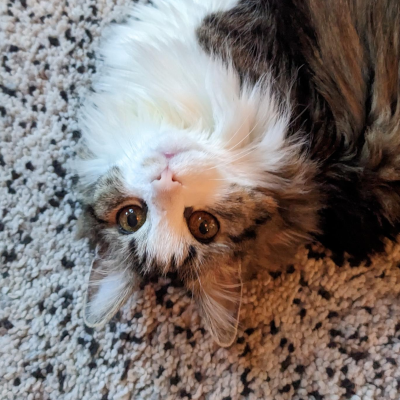
If I add some random noise to the picture, I might get this:
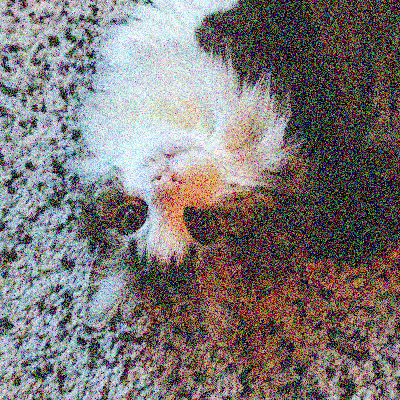
Seen side-by-side, it’s easy to see the noise:
 |
 |
The noise I added to mess up the image was random; but if I already had the messed up image, and wanted to ask what the difference between the noisy image and the true image was, I’d see something like this, which is clearly not random:
 |
 |
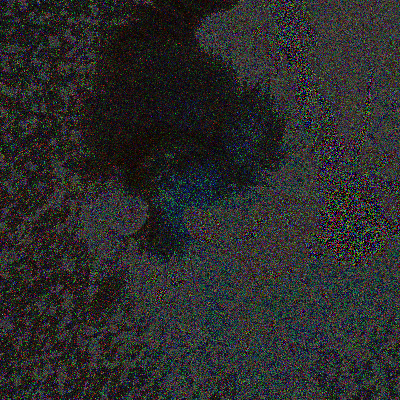 |
The core idea of a denoising algorithm is, given some data, remove the data that looks like it’s noise, leaving the data that looks consistent with what we expect things like this to look like.
So, given a picture like this:

Can I apply some magic Enhance button to clean up the image, and get a picture like this:

Or side-by-side, can I go from the left, to the right:
 |
 |
 |
Simple, right? Just fix all the bits that don’t look like a cat.
Magic Enhancement Buttons
A magic Enhance Button has long been a trope in sci-fi police procedural dramas. It’s common to see a low resolution image, taken in bad lighting, reflected off of a surface, “cleaned up” by the data techs or AI to recover details (“the killer’s face!”, “the licences plate!”) that were difficult or impossible to see in the original image.
And while some information is always present which isn’t easy to distinguish by the human eye; and some amount of information recovery is possible; there are limits, we can only recover information which is there.
This is such a common and silly trope, that it has become a point of pride in some media and tech-savy fans to point it out when it occurs in fiction.
But … what if we didn’t care if the recovered information was accurate?
What if we only cared if the recovered information were plausible?
Enhance My Cat
If I wished to build software which could take a noisy image of my cat, Eliza, and clean it up, I could now do that.
I’d start by taking a lot of pictures of my cat, on the same carpet, and messing them up to various degrees:
 |
 |
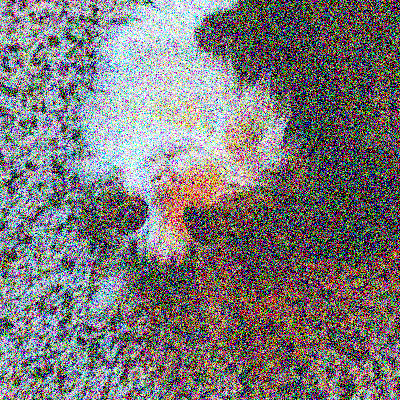 |
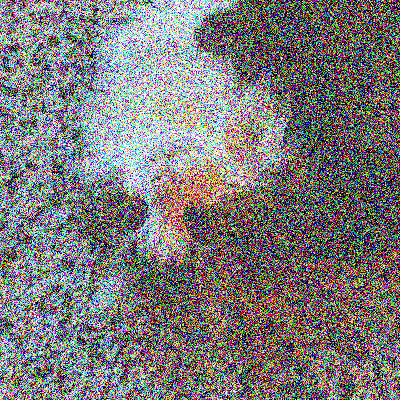 |
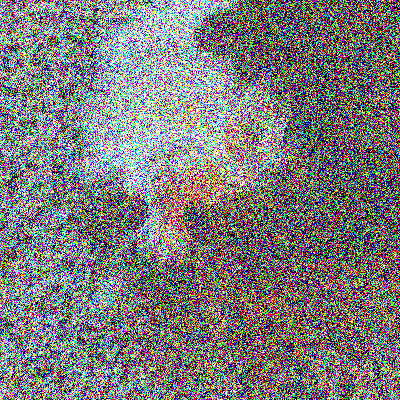 |
 |
And then I’d take the steps in this degeneration, say Step K and Step K+1, and I’d train a model to go from Step K+1 to Step K.
Teaching it to remove one step of noise from pictures of my cat:
 |
|
 |
 |
|
 |
 |
|
 |
 |
|
 |
 |
|
 |
If I trained this with just one picture, I could build a model that would be very good at starting with random noise, and when applied iteratively, would make it look more and more like a picture of my cat:
 |
|
 |
And if I trained a model on many pictures of my cat against the same background, I could start with random noise and iteratively apply that algorithm to get an image which was plausibly like a picture of my cat against the same background.
I’m leaving a lot out, like How?
This is a big field of research, there’s a lot of math and statistics involved in working out how to imagine pictures of my cat.
But what we’ve described so far is only good if every picture has the same kind of content, it’s limited because we’ve trained one statistical model to remove one kind of noise:
- Noise that doesn’t look like Eliza on a Carpet.
Denoising Lots of Things
If I want to be able to enhance / denoise pictures of lots of things other than pictures of my cat, Eliza; the simplest way would be to just train a lot of different models.
Let’s name the current model:
- “Maine coon cat laying on a white and black salt and pepper rug.”
Now, my model of my cat is certainly bigger than one picture, but it’s probably a lot smaller than all the pictures I used to train it; probably a lot smaller if I’ve used good math to do the job.
If I want to be able to denoise other things, I could train other models, say:
- “Maine coon cat sitting on a white and black salt and pepper rug.”
- “Maine coon cat laying on wooden floor.”
- “Maine coon cat sitting on a wooden floor.”
- “Planes on a runway.”
- Etc.
For a good few years, this is what people did. They built very specialized denoising models targeting exactly what they were working with. The models did a good job at enhancing those things with plausible hallucinated details; but failed spectacularly when unexpected details were mixed in.
A number of commercial image editing and enhancement packages had, internally, large libraries of models they could use to fix up images; and they’d first run other models to tell them what they were looking at (“that’s a cat”) before selecting a model from the library to apply.
But the size of these models, and the cost of training them, while individually small, is very large in aggregate. We can’t effectively create a separate model for every kind of image we ever might want to denoise, enhance, or just make up.
So we need to find a way to compress them together.
It would be nice if we could take a description of the kind of image we’re looking at, and turn it into some kind of key so that models can share information.
It would be nice if these two models could share their cat-related information:
- “Maine coon cat laying on a white and black salt and pepper rug.”
- “Maine coon cat laying on wooden floor.”
But how do we translate text into a key that models can use?
Description to Key
In 2013, along came something called word2vec.
word2vec is a form of text-vectorization. It turned words (like “cat”) into a vector of numbers, that represented a point in a semantic embedding space.
What was interesting about this was that the embedding space was learned in such a way that you could do rough “semantic math” on the results:
- “Queen” - “Female” + “Male” =~ “King”
And that rough equivalency started to enable text manipulation (Natural Language Processing) models to get pretty powerful.
Later, mechanisms to fuse series of words into vectors, which maintained some notion of their original ordering, were invented.
So, today, we can perform embedding math similar to:
- “Maine coon cat laying on a white and black salt and pepper rug.”
- - (offset:7)“white and black salt and pepper rug”
- + (offset:7)“wooden floor”
- =~ “Maine coon cat laying on wooden floor.”
Overlapping Diffusion Models
Now we can train a bigger model, much bigger than we would have trained for just one kind of thing:
- “Maine coon cat laying on a white and black salt and pepper rug.”
But trained on many, many kinds of things. But in addition to training the model on the noisy image, and the slightly-less noisy image; we’ll also show it the embedded description context, as a key.

"Maine coon cat laying on a white and black salt and pepper rug." |
|
 |

"Maine coon cat laying on a white and black salt and pepper rug." |
|
 |

"Maine coon cat laying on a wooden floor." |
|
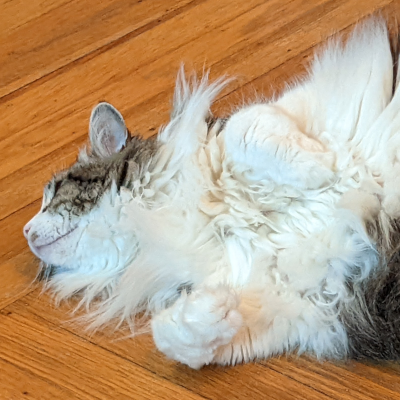 |
The embedded key lets the model decide which parts of the model to use to generate the image; and so parts which are shared according to the key between different images will be trained together and shared in the model.
Making More Data
Our models do better when we train them on more data; but we only have so much data, so … we make some up.
There are a lot of entirely mechanical things we can do which (probably) don’t change the original description.
A really common form of data-augmentation is flipping the original image:

"Maine coon cat laying on a white and black salt and pepper rug." |
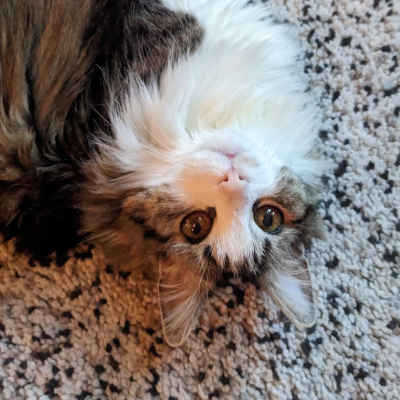
"Maine coon cat laying on a white and black salt and pepper rug." |

"Maine coon cat laying on a wooden floor." |

"Maine coon cat laying on a wooden floor." |
But if we’ve got access to image processing tools, we can augment the data and the description:
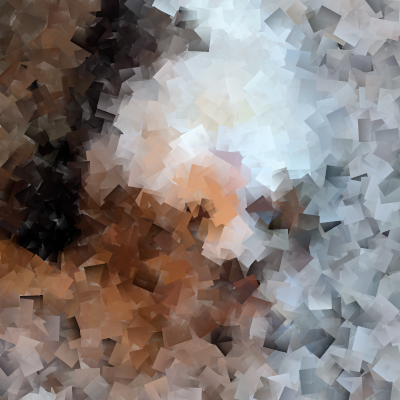
"Maine coon cat laying on a white and black salt and pepper rug. Cubism." |
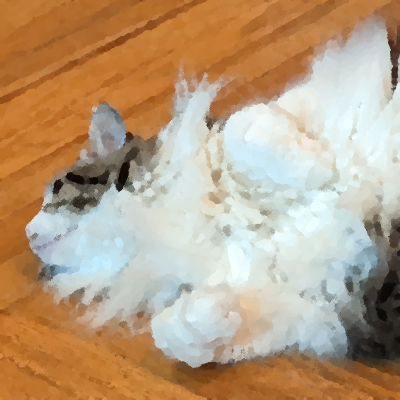
"Maine coon cat laying on a white and black salt and pepper rug. Oil painting." |
Generating New Images
We can start by generating some random noise:

And giving the model a prompt:
- “Maine coon cat laying on a carpet.”
Starting from random noise, the denoiser picks local features that are kinda plausible from the prompt, and begins moving the image towards something that has some of those features.
As parts of the image come into focus, they are forced to make sense relative to their neighbors, and the features refine towards more plausible results.
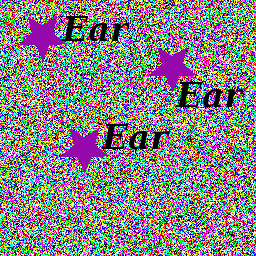
"Maine coon cat laying on a carpet." |
|
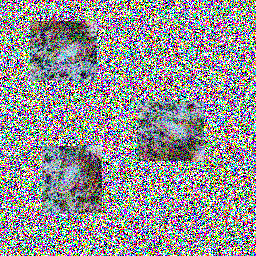 |
| ... many steps later ... | ||

"Maine coon cat laying on a carpet." |
|
 |
| ... many steps later ... | ||

"Maine coon cat laying on a carpet." |
|
 |
Novel Combinations
Once we’ve got this big overlapping model, keyed on embedded descriptions; we can start asking it for things we don’t have pictures of:
- “Main coon cat laying on runway on Mars.”
The question of “Does this Work?” is tied up in the math of how good a job we did on the math for the text embeddings; and how good a job we did on the math of how the model uses those embeddings to decide which parts of itself to use for a given problem.
It’s all about sharing the appropriate things; and is a very active field of research. They year-over-year improvements in the basic math are, at this point, astounding; and we have no reason to currently believe that the surface has really been scratched on the math.
- Everyone expects this math to get MUCH better, quickly.
How does this give us Art?
All AI Art Models are using variations of this technology; and they’re trained upon art, and generated and augmented images.
Many of them are also crowd-sourcing the up and down votes on the new images they produce, and using them to further augment and train the dataset for the models they train.
The more images a model has been trained with, and the better the descriptions of those images, the better the results will tend to be.
There are lots of mathy details, and lots of active research; but that’s the gist.
Is this a copy of the training data?
The very, very short answer is: No.
Examining the data for open source AI Art Model (so we can look at the sizes of things) Stable Diffusion
Some numbers there:
- trained on 2.3 billion 256x256 3-color 24 bit images
- trained on ~= 450 terrabytes
- model size: 4.2 gigabytes
- 100000 / 1 ratio of training data to model size
- ~= 2 bytes of model data for every training image
And this is ignoring the size of the text prompts in the training; and their representation in the model’s embedding spaces.
Technically, mathematically, the model contains at most 2 bytes of information for every training image. Were we to claim it had copied the training data, we’d need to argue that we can compress a 256x256 image down to less than one pixel; to just 16 numbers; so it seems impossible to argue that the model has copied the data. What the model has done is learned how to describe things like each input image, in terms of and relative to other images it has seen, conditioned on the embedding contexts it was given.
It’s pretty compelling to me to argue that the training data isn’t in the model; the models have learned what high level concepts imply; concepts like:
- Cat
- Oil Painting
- Picasso
Now, some of those concepts are tightly coupled with the style and work of current artists and companies with a stake in IP law and financial survival, which raise other interesting and important questions:
- is it ok to learn from IP controlled information, even without copying it?
- what are the limits on this?
- is this covered by existing law and contracts?
- do we need new law and contracts?
- do we want to extend IP to cover style and inspiration?
- can we do this in a way which doesn’t hurt artists more than it helps them?
Is this just copying by obfuscation?
I want to call out a point here. The above argument (2 bytes per training example can’t be copying) is extremely compelling to me; and I’ve found it to be compelling to others with a formal background in information theory, we see it as wildly too small to be anything like a compression or copy of the source data.
But it isn’t a compelling argument to many people without that background. The feedback I’ve received is that they’re concerned this is a form of shell game, copying by obfuscation. They’re moving the math around to hide the trick, is the argument.
And I don’t know how to counter that argument, without saying “learn the math”; but it feels like a real crux of one of the issues here.
In discussion with people, when it feels like some progress is being made on the question of, is this copying in some sense, an even more interesting objection arises, that I’ll paraphrase here:
The argument against robotic fair-use:
While this might not be copying, I object to calling this “learning” and I’m unhappy with the idea that this is ok.
Humans have a fair-use right to learn from material, that grants them moral rights to observe and consider things which supersede the rights of the creators of art to control the use of their material. The right to observe is protected above other rights.
Calling this “learning” implies that right; but the computer isn’t a person, and so can’t have that moral right. The information derived from observing art, even if it conclusively isn’t a copy, is still violating rights of the author of the training examples which take precedence because they are not being superseded by fair-use rights to observe.
Humans should have a legal right to look at things without compensation that robots should not have.
I believe that there is a deep cultural divide on this argument, and it’s worth clarifying what the actual disagreement is when moving forward with AI training. I think some people accept this strongly as deeply and morally true, and some people reject it strongly as deeply and morally untrue; and bringing this question forward is more clarifying of that disagreement than an argument about the information content of a model.
Is it legal to train on copyrighted art?
This seems like a simple question, but we can probably break it down into a whole family:
- Should it be legal to train on copyrighted art?
- Is it legal to train on copyrighted art in jurisdiction X?
- If no, is it legal to look at copyrighted art, as an artist?
- What is the difference?
- Should artist be a protected financial job?
But we can kick this back further:
- When AI is taught to do a job, what do we owe to the people who are losing work to that AI?
I, and many other people, have strong opinions about these issues, but this isn’t a post about the law or the ethics of applying AI to existing industries.
Expect a lot of lawsuits and new legislation in this space for the rest of ever; this question isn’t going away.